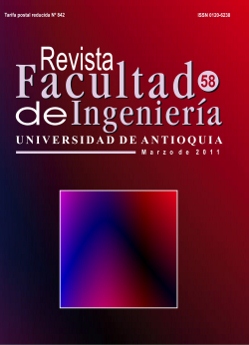Airplane of the muda: support tool for the teaching-learning experience of lean manufacturing
DOI:
https://doi.org/10.17533/udea.redin.14611Keywords:
lean manufacturing, game, teaching-learning, problem-based learning, collaborative learningAbstract
This paper proposes a game called “Airplane of the muda”, designed to complement the theoretical classes of lean manufacturing with practical elements allowing to incorporate constructivist principles and collaborative learning based on the teaching-learning process problems of: 7 mudas, 5’S and visual management. This game is exposed based on a theoretical framework for lean manufacturing and some learning theories. Then, provides: case study, materials, distribution, roles, procedures and production runs with the corresponding characterization in cycle times and tack time. From the academic point of view a gap in knowledge is fi lled in the specifi c fi eld for which the article was developed, and besides at a general level there is information for faculty, students and researchers, such as: ideas for future work and methodological elements that serve as a guide to study and generate other games, to support theoretical courses. On a practical level, given its design, simplicity and accessibility of materials needed, the game can be deployed as it is on Lean manufacturing courses of any institution.
Downloads
References
GEIO. Lúdicas y laboratorios de Ingeniería Industrial. Universidad Tecnológica de Pereira. Pereira. 2007. pp.1-1014.
A. Espejo, F. Moyano. “Lean production: estado actual y desarrollo futuro de la investigación”. Investigaciones europeas de dirección y economía de las empresas. Vol. 13. 2007. pp. 179- 202.
J. Womack, D. Jones, D. Ross. The machine that changed the world: The story of lean productionToyota’s secret weapon in the global car wars that is now revolutionizing world industry. Ed. Simon & Schuster. New York. 2007. pp.1-352.
W. Feld. Lean manufacturing: tools, techniques and how to use them. Ed. The St Lucie Press.APICS Series on Resource Management. 2001. pp.1-228. DOI: https://doi.org/10.1201/9781420025538
S. Ho, S. Citmill. “Japanese 5-S practice”. The TQM magazine. Vol. 8. 1996. pp. 45-53. DOI: https://doi.org/10.1108/09544789610107261
S. Spear. “Learning to lead at Toyota”. Harvard Business Review. Vol. 82. 2004. pp. 78-86.
M. Imai. Kaizen: la clave de la ventaja competitiva japonesa. A. Tr. Vasseur (editors). Ed. Cecsa. México.1989. pp.1-298
T. Ohno. Toyota production system: beyond large-scale production. Portland (Oregón). Ed. Productivity Press. 1988. pp.1-143.
J. G. Arrieta. “Las 5s, pilares de la fabrica visual”. Revista Universidad EAFIT. Abril -Junio. N.° 114. 1999. pp. 35-48.
C. Andriani, R. Biasca, M. Rodríguez. Un nuevo sistema de gestión para lograr PYMES de clase mundial. Ed. Norma. México. 2003. pp.71-72.
Y. Monden. El just In time hoy en Toyota. Ed. Deusto. Madrid. 1996. pp. 1-437.
K. Luna, C. González. Implementación de sistemas de calidad en la industria de la construcción: hacia un modelo cualitativo de evaluación. Ed. ACE. Vol.1. 2007. pp. 419-420.
F. González. “Manufactura esbelta (Lean manufacturing): Principales herramientas”. Revista panorama administrativo Vol. 2. 2007. pp.93-96.
M. Imai. Cómo implementar el Kaizen en el sitio de trabajo. Ed. McGraw Hill. España. 1998. pp. 85-86.
J. Berengueres. The Toyota production system recontextualized. Lulu.com. London (U. K.). 2007. pp.1- 80.
A. Bednar, D. Cunningham, T. Duffy, J. Perry. Theory into practice: how do we link. G. Anglin. Ed. Instructional technology: past, present and future. Denver, CO: Libraries unlimited. 1991. pp. 88-101.
D. Jonassen. “Objectivism vs. constructivism: do we need a new philosophical paradigm” Educational technolgy research and development. ETR&D. Vol. 9. 1991. pp. 5-14. DOI: https://doi.org/10.1007/BF02296434
M. Guzmán. “El modelo constructivista del aprendizaje”. Revista Enfoques educativos. Vol. 16. 2008. pp. 78-98
D. Johnson, D. Johnson, E. Holubec. Cooperation in the classroom. 7 ed. Ed. lnteraction book company. Edina. (MN). 1998. pp. 1-2.
J. Pérez, P. Jaramillo, L. Moreno. “El comercio de canicas: herramienta de apoyo para la enseñanzaaprendizaje práctico de la programación lineal”. Revista Facultad de Ingeniería UCV. Vol. 25. 2010. pp. 43-52.
H. Barrows. “A taxonomy of problem based learning methods”. Medical education. Vol. 20. 1986. pp. 481-486. DOI: https://doi.org/10.1111/j.1365-2923.1986.tb01386.x
L. Branda. Aprendizaje basado en problemas, centrado en el estudiante, orientado a la comunidad. Aportes para un cambio curricular en Argentina. Jornadas de cambio curricular de la Facultad de Medicina de la Universidad de Buenos Aires. Organización panamericana de la salud. Buenos Aires. 2001. pp. 79- 101.
H. Nieme. “Active learning a cultural change needed in teacher education and schools”. Teacher and teaching education. Vol. 18. 2002. pp. 763-780. DOI: https://doi.org/10.1016/S0742-051X(02)00042-2
R. Felder, L. Silverman. “Learning and teaching styles”. Engineering education. Vol. 78. 1988. pp. 674- 681.
R. Ortega. Play, activity and thought: refl ections on Piaget’s and Vygotsky theories. D Lytle (Editors.). Ed. Play & culture studies. London: Praeger. 2003. pp. 99- 115.
R. Ortega. “El juego: la experiencia de aprender jugando”. J. Gallego, E. Fernández, (Editors). Enciclopedia de educación infantil. Málaga: Aljibe. 2003. pp. 765-787.
Downloads
Published
How to Cite
Issue
Section
License
Copyright (c) 2018 Revista Facultad de Ingeniería

This work is licensed under a Creative Commons Attribution-NonCommercial-ShareAlike 4.0 International License.
Revista Facultad de Ingeniería, Universidad de Antioquia is licensed under the Creative Commons Attribution BY-NC-SA 4.0 license. https://creativecommons.org/licenses/by-nc-sa/4.0/deed.en
You are free to:
Share — copy and redistribute the material in any medium or format
Adapt — remix, transform, and build upon the material
Under the following terms:
Attribution — You must give appropriate credit, provide a link to the license, and indicate if changes were made. You may do so in any reasonable manner, but not in any way that suggests the licensor endorses you or your use.
NonCommercial — You may not use the material for commercial purposes.
ShareAlike — If you remix, transform, or build upon the material, you must distribute your contributions under the same license as the original.
The material published in the journal can be distributed, copied and exhibited by third parties if the respective credits are given to the journal. No commercial benefit can be obtained and derivative works must be under the same license terms as the original work.










 Twitter
Twitter